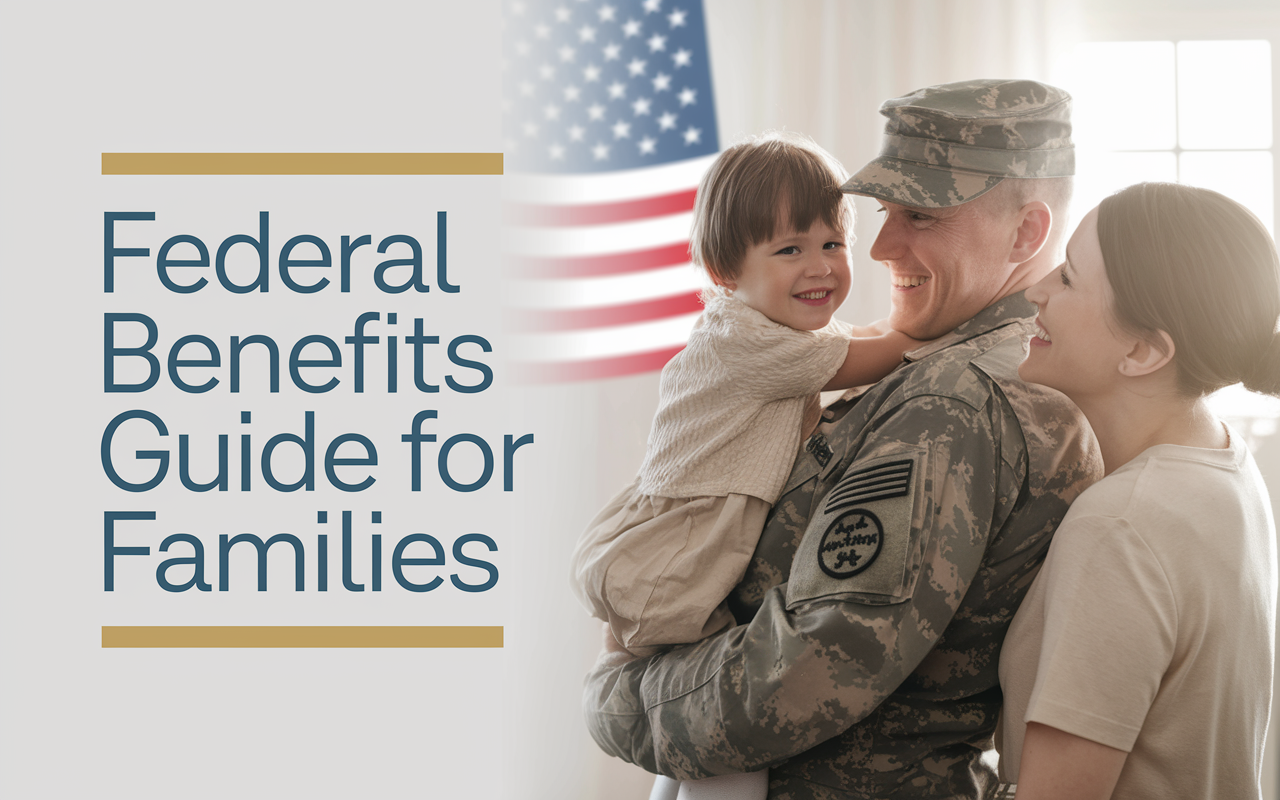Comprehensive Federal Benefits Guide for Military & Civil Service Families (2025 Revision)
For over three decades, we at PlanWell have had the honor of guiding those who serve—whether in uniform or as faithful civil servants—through the many layers of federal benefits and survivor protections. We understand the anxieties that come with ensuring a loved one’s financial security, particularly when dealing with multiple agencies and evolving benefit programs. Armed with the Chartered Federal Employee Benefits Consultant℠ (ChFEBC), Certified Financial Planner™ (CFP®), and Accredited Investment Fiduciary® (AIF®) designations, our team has created the Fed-Expert Financial Blueprint to clarify every step of planning for retirement and protecting beneficiaries. This 2025 revision of our comprehensive guide will walk you through essential programs like the Survivor Benefit Plan (SBP), Dependency and Indemnity Compensation (DIC), and the VA Survivors Pension (for wartime veterans’ survivors), as well as FERS and CSRS survivor benefits. Our aim is to help you feel more informed when providing for your family—both now and in the years to come.
Introduction: Setting the Stage for Security
Whether you are a military retiree, an active-duty service member, or a federal employee, it’s natural to wonder what would happen to your loved ones if anything happened to you. Survivor benefits and beneficiary planning exist precisely for this reason: they’re designed to protect families from sudden financial hardship. Yet navigating the specifics can be daunting. Every benefit has unique eligibility criteria and paperwork requirements—one wrong assumption could leave survivors without vital support.
At PlanWell, we help you cut through the noise. Our goal is to simplify each step, ensuring you know about key programs like SBP, DIC, and the VA Survivors Pension for wartime veterans, as well as FERS or CSRS survivor annuities for eligible federal employees. With the SBP-DIC offset fully eliminated, plus 2025 updates across VA pension rules, it may be beneficial to reevaluate your beneficiary designations. Being proactive can spare your loved ones frustration and uncertainty, allowing them to focus on healing instead of paperwork.
Understanding Survivor Benefits for Military Families
Military service members, whether active or retired, often rely on multiple layers of benefits to provide a financial safety net for their families. Three notable pillars include the Survivor Benefit Plan (SBP), Dependency and Indemnity Compensation (DIC), and, for those who qualify, the VA Survivors Pension. Although each program has distinct criteria, understanding how they interact can help you better assess support for those left behind.
Military Survivor Benefit Plan (SBP)
The Survivor Benefit Plan (SBP) offers an ongoing monthly annuity for your surviving spouse or eligible children. For those on active duty, SBP coverage is generally automatic and free if death occurs in the line of duty. Once in retirement, SBP is an elective benefit with corresponding premiums deducted from your retired pay. In most cases, the monthly benefit pays up to 55% of your base retired pay, adjusted annually for inflation.
Although SBP participation is not mandatory for retirees, it serves as a substantial source of long-term financial protection. If you pass away in retirement, your spouse or designated beneficiaries receive this annuity, helping offset the loss of your retired pay. Since the offset with DIC has been eliminated, families potentially gain even more security if they qualify for both programs. Properly coordinating applications and paperwork is critical to receiving all available benefits.
Dependency and Indemnity Compensation (DIC)
DIC is awarded by the Department of Veterans Affairs to the survivors of veterans who have died as a result of service-connected disabilities or conditions. Unlike SBP, DIC has no premiums—your eligibility rests entirely on the cause of death being linked to military service. The base DIC rate adjusts periodically for cost-of-living increases, and additional allowances may apply for dependent children or certain qualifying situations.
The key to unlocking DIC is establishing that the veteran’s passing was service-related. Recent changes allow concurrent receipt of SBP and DIC. Although this is a significant development for beneficiaries, being precise with your documentation is important to avoid any delays in receiving funds. If you’re also looking into the VA Survivors Pension, remember that DIC is generally for service-connected deaths, while the pension is a means-tested benefit for eligible survivors of wartime veterans.
VA Survivors Pension (Wartime, Needs-Based)
A common misunderstanding is that the VA offers a universal “survivor pension” to all families of deceased veterans. In reality, there is a needs-based program known officially as the VA Survivors Pension—sometimes called the “Death Pension”—only available to certain survivors of wartime veterans. To qualify, the veteran must have served during a designated wartime period, must not have been dishonorably discharged, and the surviving spouse (or dependent children) must meet specific income and net worth limits. For 2025, the net worth threshold is set at $159,240.
The Maximum Annual Pension Rate (MAPR) for a surviving spouse with no dependents is $10,989 for December 1, 2024, to November 30, 2025. However, the actual payment you receive will be calculated by subtracting your countable income from the appropriate MAPR, then dividing by 12. Higher MAPRs may apply if you qualify for Housebound status ($13,356) or Aid & Attendance ($18,008). Because these benefits are income-tested, any additional resources or assets you hold can reduce—or eliminate—your VA Survivors Pension amount. It’s advisable to consult the official VA factsheet for a detailed explanation of the rules and application process.
Survivor Benefits for Federal Civil Service Families
Federal employees—whether part of the Federal Employees Retirement System (FERS) or the older Civil Service Retirement System (CSRS)—also have access to survivor benefits. These programs were designed to mirror some aspects of military benefits in ensuring a steady stream of support after a death.
FERS Survivor Benefits
FERS covers most employees who began federal service in 1984 or later. If you have at least 18 months of creditable service under FERS, your surviving spouse and children could be eligible for monthly annuities or a one-time lump sum. Typically, the spouse’s monthly benefit is 50% of the retiree’s annuity, with cost-of-living adjustments each year.
FERS also brings structured rules around beneficiary designations and spousal consent. Marital changes—marriage, divorce, or remarriage—can alter who is entitled to benefits. Because these designations can become complicated, periodic reviews of your FERS and life insurance forms are a must. Something as simple as remembering to update your paperwork after a major life event can help ensure your intended survivors receive what you have planned for them.
CSRS Survivor Benefits
Although the majority of new hires fall under FERS, some longtime federal workers remain in the Civil Service Retirement System (CSRS). CSRS lets you elect a survivor annuity that pays up to 55% of your annuity amount upon your passing. The eligibility formula is tied to your years of service and the type of enrollment you choose.
Like FERS, CSRS survivor benefits hinge on correct enrollment and accurate beneficiary updates. Because CSRS has different calculation methods, it’s important to know precisely what your spouse or dependent children will receive. If you’re not sure which system applies to you or if you’ve combined service under both, a professional review can help clarify the benefits you qualify for when coordinating CSRS, FERS, and any related coverage like the Thrift Savings Plan (TSP).
Military and Federal Service Recognition
Service to our nation is recognized beyond simple financial payments. Both the Department of Defense and the Department of Veterans Affairs offer memorial benefits, and the Office of Personnel Management (OPM) oversees certain life insurance options for federal employees. These additional programs ensure that “those who serve” and their families are provided not just compensation, but also honor and recognition.
Burial and Memorial Benefits
Fallen veterans and their eligible family members may qualify for burial in a VA national cemetery, government-furnished headstones and markers, and a burial flag. To speed up the process and ensure your family receives these honors, keep your discharge papers (DD Form 214) in a secure but accessible location. Federal employees who are also veterans might have overlapping benefits in this area, so it’s crucial for families to understand which organization—DoD or VA—steers the application process for funeral honors.
Life Insurance Programs
When on active duty, servicemembers generally have Servicemembers’ Group Life Insurance (SGLI) coverage. After separation or retirement, they can convert SGLI to Veterans’ Group Life Insurance (VGLI). Additionally, Family Servicemembers’ Group Life Insurance (FSGLI) extends coverage to spouses and dependent children. In parallel, federal employees typically have Federal Employees’ Group Life Insurance (FEGLI) offered under OPM.
Balancing multiple life insurance policies is entirely possible, but you must keep beneficiary designations up to date. Changes in marital status, the birth of children, or adoption can drastically alter whom you want listed. By regularly confirming your forms, you can plug common gaps that arise when families assume coverage automatically goes to their “nearest” relative rather than whoever is officially designated.
Health & Transitional Benefits for Survivors
While finances are crucial to your family’s well-being, maintaining health care coverage can prove just as important. From the Federal Employees Health Benefits (FEHB) program to CHAMPVA, a variety of programs offer transitional or extended coverage to help survivors avoid losing access to essential medical care.
Federal Employees Health Benefits (FEHB)
FEHB is a significant benefit for many federal workers, known for its broad network of providers and multiple plan tiers. If you’re called to active duty, FEHB may continue for up to 24 months. Returning service members are also often eligible for transitional TRICARE coverage for 180 days. In the event of a federal employee’s death, if the surviving spouse qualifies for a FERS or CSRS survivor annuity and was covered under FEHB at the time of death, they can typically maintain FEHB into the future. This can provide significant financial relief, particularly for older survivors in need of reliable—and more affordable—health care options.
VA Health Care for Survivors
CHAMPVA (the Civilian Health and Medical Program of the Department of Veterans Affairs) is an option for surviving spouses or dependent children of veterans who are rated permanently and totally disabled due to a service-connected condition, or who died from a service-connected disability. CHAMPVA helps pay for a wide array of medical services and supplies. Because eligibility for CHAMPVA differs from FEHB, surviving families who split time between federal employment and military service need to ensure both programs are logically coordinated, preventing any unexpected lapse in medical coverage.
Key Considerations & Beneficiary Planning Insights
As you plan for your family’s future, keep these points in mind. First, confirm enrollment or eligibility for critical programs like SBP well before retirement to avoid missing any windows for election. Second, regularly review beneficiary designations for FERS, CSRS, TSP, and life insurance policies—especially after life events such as marriage, divorce, or birth of a child. Third, confirm that your survivors meet any age or marital status criteria tied to benefits. And finally, note that some benefits (like SBP and DIC) can now be earned simultaneously, but getting your paperwork in order is vital for seamless processing.
We often meet families who feel unsure about how these pieces fit together. That’s exactly why we created the Fed-Expert Financial Blueprint and offer free educational opportunities. If you’d like a deeper understanding of how to merge your various federal and military benefits—Survivors Pension, SBP, DIC, or FERS/CSRS survivor annuities—consider joining one of our free Federal Retirement Planning Workshops or a FERS webinar. Walking step by step through each program can help reduce confusion, streamline your documentation, and assist in ensuring your loved ones have lasting security.
SBP vs. DIC: A Quick Overview
Two of the most significant survivor benefits for military families are SBP and DIC. While SBP is funded through premiums deducted from retirement pay (or provided at no cost for line-of-duty deaths), DIC is awarded by the VA when a veteran’s death is service-related. Here’s a simple look at how these benefits differ:
|
Program |
Coverage Amount |
Eligibility Criteria |
Premiums or Costs |
How to Apply |
|---|---|---|---|---|
|
SBP (Active or Retired) |
Up to 55% of pay |
Spouse/Children of Service Members |
Premium for retirees; no-cost if active duty death |
Complete DD Form 2656 during retirement processing |
|
DIC |
Flat rate (adjusted annually) |
Surviving Spouse/Children/Parents of Vet (service-related death) |
No premium |
Submit VA Form 21-534 |
Because the SBP-DIC offset has been fully removed, survivors eligible for both programs can potentially receive both sets of payments. This development can be a financial benefit for families who need significant monthly income after a loss.
FERS/CSRS Survivor Benefits in Snapshot
Meanwhile, on the civilian side, FERS and CSRS each offer survivor annuities. The differences in required service and payout percentages can be critical to how much your family actually receives:
|
Benefit System |
Minimum Service Required |
Survivor Annuity Percentage |
Eligible Family |
Lump-Sum Options |
|---|---|---|---|---|
|
FERS |
18 months |
Generally 50% of retiree’s annuity |
Spouse/Children |
Possible if no monthly annuity is chosen |
|
CSRS |
Usually 5 years |
Up to 55% of retiree’s annuity |
Spouse/Children |
Possible if no monthly annuity is chosen |
If you’re uncertain about which system you fall under or the exact approach to designating beneficiaries, it’s helpful to consult an advisor who specializes in federal retirement. The interplay between these systems can be intricate, especially if your federal service is combined with prior military service.
Overview of Health Programs for Survivors
Financial support is only one part of caring for your loved ones when you’re gone. Access to high-quality health insurance is equally pivotal. FEHB or CHAMPVA may help ensure your beneficiaries remain covered:
|
Program |
Who Is Covered |
Coverage Duration |
Enrollment Notes |
|---|---|---|---|
|
FEHB |
Surviving spouse and eligible children |
Continues if spouse qualifies for survivor annuity |
Survivor must already be on FEHB at time of employee’s death |
|
CHAMPVA |
Surviving spouse and dependent children of certain disabled/deceased vets |
Varies by eligibility |
Apply via VA; separate from FEHB |
A common roadblock lies in not filing promptly or misunderstanding transitions between these programs. If you fail to enroll or update coverage within required timeframes, you risk losing benefits that otherwise would have been available. When in doubt, make sure to check the official guidelines or speak with a qualified professional.
Conclusion & Next Steps
Survivor benefits—whether under SBP, DIC, the VA Survivors Pension for wartime veterans, or FERS/CSRS annuities—all share a single purpose: honoring your service or federal career by providing financial protection for those you cherish most. Yet each program’s nuanced rules and deadlines mean there is no one-size-fits-all solution. Taking the time to clarify eligibility and properly complete the necessary documentation can spare your family complications in what would already be a difficult time.
Remember that coordinated planning yields advantageous results. If you are juggling multiple federal and military benefits, or you simply want reassurance that you’ve covered all bases, our Fed-Expert Financial Blueprint can walk you through each detail. We invite you to reach out to PlanWell’s financial advisors for federal employees if you have questions. You’re also welcome to sign up for one of our free Federal Retirement Planning Workshops or our FERS webinars to learn more about how these programs can safeguard your family’s quality of life. By getting fully informed and staying up to date, you can lay the groundwork for enduring peace of mind—and a legacy of security for those you love.












